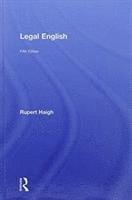
- Format
- Inbunden (Hardback)
- Språk
- Engelska
- Antal sidor
- 372
- Utgivningsdatum
- 2018-06-13
- Upplaga
- 5 New edition
- Förlag
- Routledge
- Illustratör/Fotograf
- color 18 Tables
- Illustrationer
- 18 Tables, color
- Dimensioner
- 234 x 156 x 25 mm
- Antal komponenter
- 1
- ISBN
- 9781138094703
Legal English
Kundrecensioner
Övrig information
Rupert Haigh graduated from Cambridge University in 1992 and qualified as a solicitor of the Supreme Court of England and Wales in 1997. He also holds an LLM in Public International Law from Helsinki University and a TEFL (Teaching English as a Foreign Language) certificate. After completing his legal training, Rupert worked for several years as a practising solicitor in England, specialising mainly in litigation work, before moving to Finland in 2000 since when he has been continuously involved in training legal professionals in Finland and across Europe.
Innehållsförteckning
1: Preface; 2: PART ONE: WRITTEN ENGLISH; 3: Chapter 1: Introduction to Legal English; 4: Chapter 2: Grammar for Legal Writing; 5: Chapter 3: Punctuation for Legal Writing; 6: Chapter 4: Sentence Structure; 7: Chapter 5: Legal Writing Standards: Dates, Numbers, Citations & Headings; 8: Chapter 6: Terminology & Linguistic Peculiarities; 9: Chapter 7: Elements of Good Style: Clarity, Consistency, Effectiveness; 10: Chapter 8: What to Avoid; 11: Chapter 9: British & American English; 12: Chapter 10: Contracts: Structure & Interpretation; 13: Chapter 11: Contract Clauses: Types & Specimen Clauses; 14: Chapter 12: Drafting Legal Documents: Language & Structure; 15: Chapter 13: Correspondence, Memoranda & Essays; 16: Chapter 14: Applying for a Legal Position; 17: Chapter 15: Self-Study Exercises; 18: PART TWO: SPOKEN ENGLISH; 19: Chapter 16: Aspects of Spoken English; 20: Chapter 17: Meeting, Greeting & Getting Down to Business; 21: Chapter 18: Interviewing and Advising; 22: Chapter 19: Dealing with Difficult People: Ten-Point Guide; 23: Chapter 20: Court Advocacy; 24: Chapter 21: Negotiation; 25: Chapter 22: Chairing a Formal Meeting; 26: Chapter 23: Making a Presentation; 27: Chapter 24: Telephoning; 28: Glossaries; 29: Answer Key; 30: About the Author
Du kanske gillar
-
Who is Government?
Michael Lewis
Inbunden -
Not One Inch
M E Sarotte
Häftad -
Midnight and Blue
Ian Rankin
Häftad -
Criminal Profiling
Brent E Turvey
Inbunden
